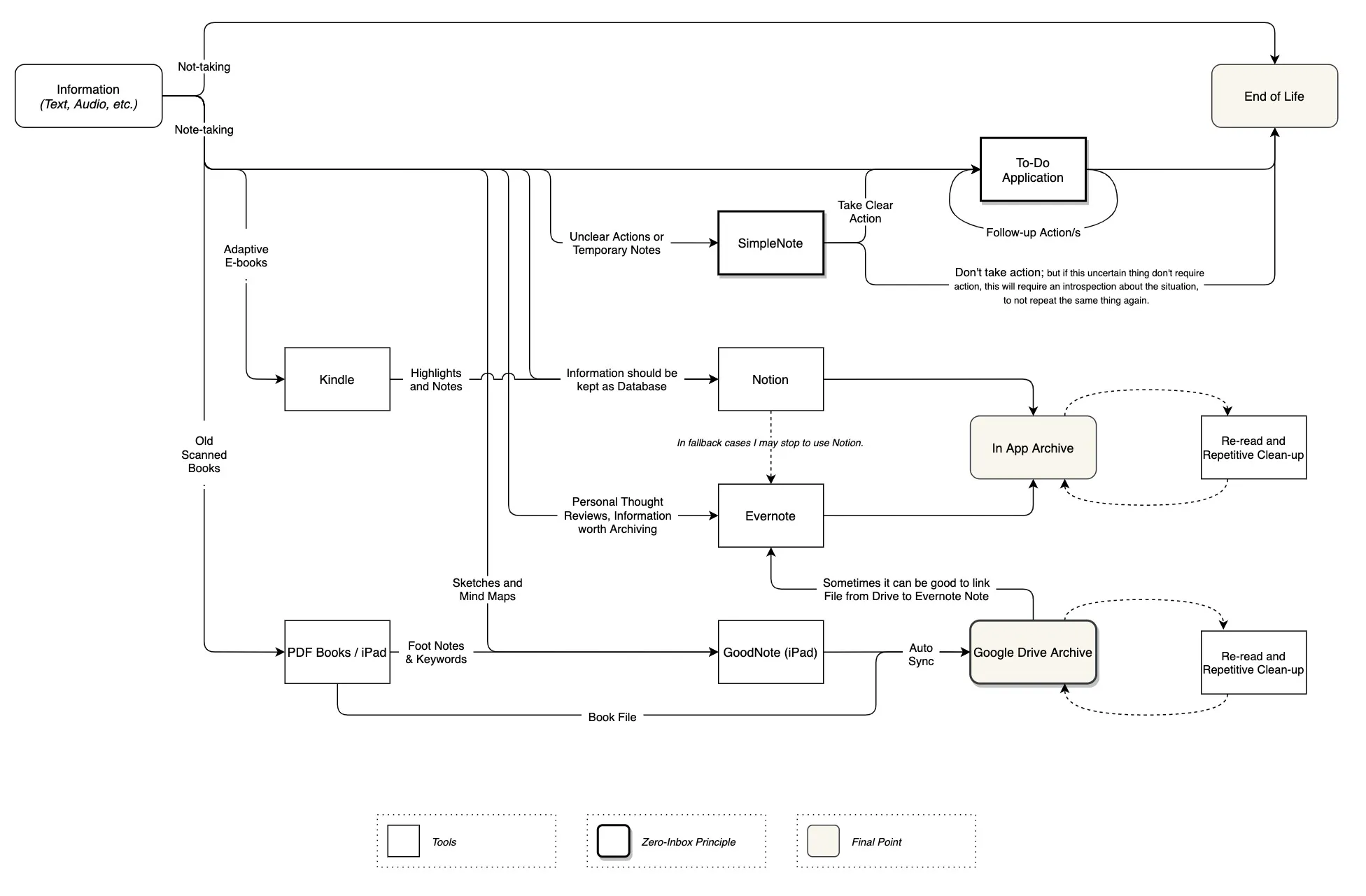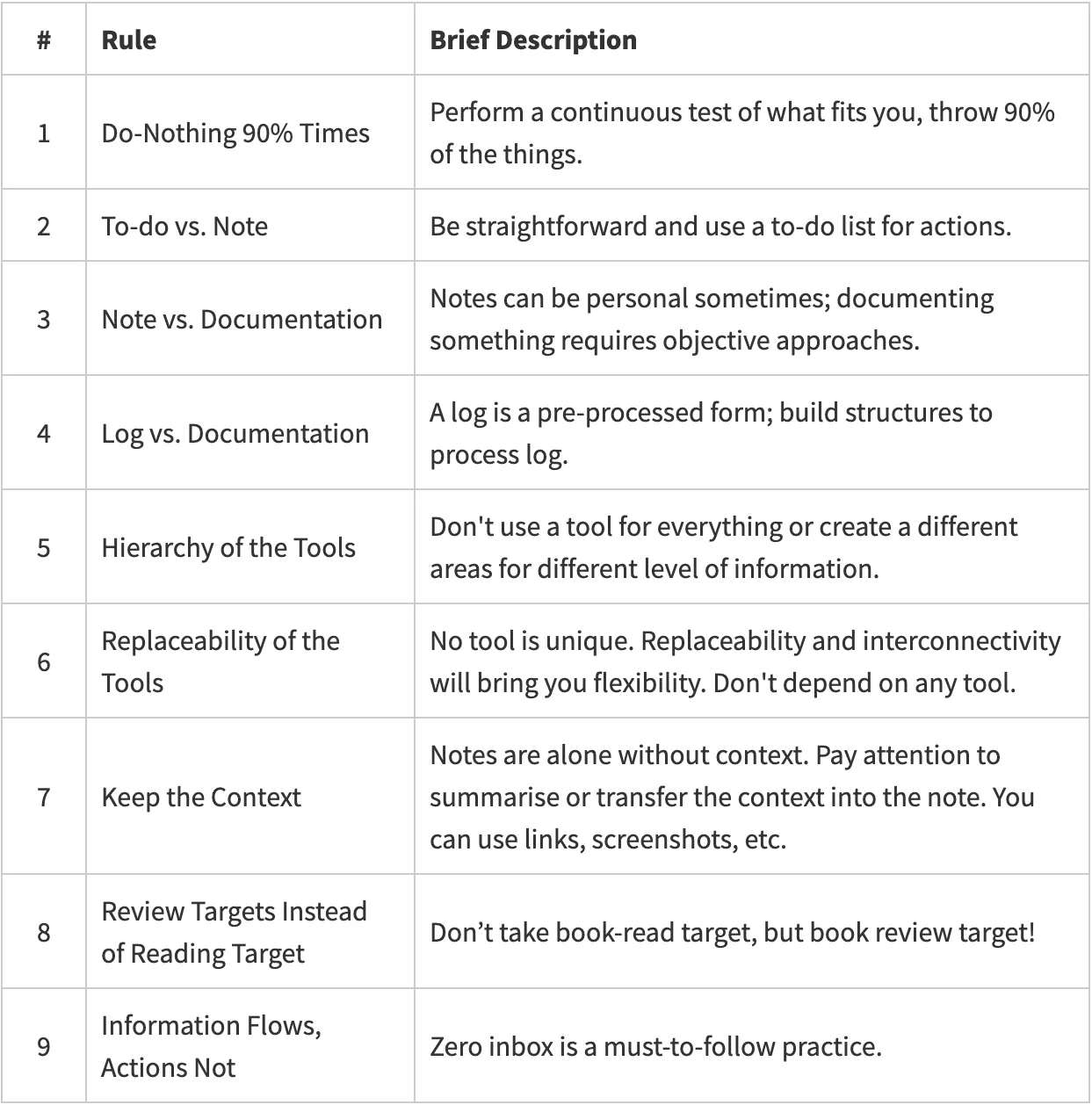We’re all building a continuous delivery pipeline called learning. Each information has a lifecycle and lifetime. And the info is combining with others to be a strong knowledge or being eliminated by falsification.
We need to forget what we learned about learning because of the increased speed of information and increased books. We need to know how to perceive, keep, discard, read, and spend time on these changes. And what to note. This post is my brief rulebook about taking a note and not taking it.
Before diving into the rulebook, let’s have a simple pipeline example. In this blog post, I’ll mainly focus on the B section. I also have some practices and tips for C (how to efficiently follow-up personal and business actions/notes) and A (how to pick and reduce the sources) titles, but I won’t handle them in this post.

The Rulebook
1/9) Do-Nothing 90% Times
-
Behave picky, test what worth taking note of and what not worths it. It is a continuous process to test and validate what deserves your focus.
-
Subscribe to the newsletters, and then if it’s not working well and you don’t like the level of detail; unsubscribe.
-
I’m just choosing 1 of 10 books; I’m keeping 1 of 10 newsletters as average. I don’t know this is general, but I wished to call this rule “90% times”.
Doing nothing is an active process. Recognize this!
2/9) To-do vs. Note
-
To-do and notes are different, shouldn’t be mixed in the same medium/tool.
-
In a meeting, don’t take notes like highlighting something. Every note should be in a to-do format and simple. More straightforward is more useful;
“Mesut: will provide the report before 20th Jan.”
- Don’t worry about being straightforward; writing notes as a direct to-do is doing nothing. But the opposite, taking to-do notes like a quote or in a soft format (!) can decrease understandability.
3/9) Note vs. Documentation
-
Taking note and documenting something is different. For business purposes, don’t take notes; do documentation or mark a to-do.
-
As a product manager, I saw the harms of notes; when you heard something, don’t write it down as it is; at least write it as “Check the insight from X user …” Because, after some time, maybe at the end of the day you can forget what was the intention of your note, was that a real priority?
-
Because in business cases, subjectivity is so low, and the decisions aren’t personal. It would be best if you learned to differentiate between personal and business spaces.
-
And don’t find any excuse for forgetting proper note-taking. If you’re busy finding a flexible and easy format, taking note/action is easy as “Hey Google, please remind me …”
-
Implementing a structure is not paperwork; in contrast, it should help you.
The structure is for lazy people. Be lazy!
4/9) Log vs. Documentation
- A log is a pre-processed form of documentation and a to-do set. Meeting notes and transcripts generally are a kind of log. There is different kind of logs or lists you can do. These logs shouldn’t remain as logs, should be converted into actions or documentation;
-
Transcript / Business Decisions: It should be converted into strategy (documents) or actions.
-
Your favourite bookmarks: what to do with these, will you study these later?
-
Self-experiment logs: After you end your experiment, convert or explain them with a description, this will transform logs into the documentation.
-
Personal expenses: Don’t keep as a text format; convert the log into an excel or database structure.
-
Examples can continue.
5/9) Hierarchy of the Tools
- Memory works hierarchically, so notes and their places should be. I suggest to differentiate the tools for different hierarchical levels or create separate areas for various purposes. My example for the differentiation is below.

My toolset for the different hierarchical level of information
If you don’t need a tool review, skip this title.
1. Simplenote:
-
Why: If there is some temporary note or something that waits to be specific, I’m using Simplenote.
-
Post-Note Action: Trying to make the Simplenote list count zero, like zero inbox practice. All of the notes should be transferred to Todoist, and after that, the note should be deleted. There shouldn’t be any archive here.
2. Todoist:
-
Why: To build to-do, to-read, and to-purchase lists, I’m using Todoist.
-
Post-Note Action: The list should be zero-item long. Zero-inbox also works here.
3. Evernote:
-
Why: To keep long-term and non-business related notes here.
-
Post-Note Action: Do a backward compatibility check within the notes, like a backlog grooming.
4. Notion:
-
Why: To keep a database like notes here. I think, Notion is not a useful note-taking application;
-
It’s slow; because of the lack of native apps, I feel sluggish on Notion.
-
Also, because of the Notion’s structure, creating a note is slower than Evernote, etc. There is some milliseconds delay. (OneNote developers added a short note section inside the app, I think Notion developers can regard this, but it’ll reduce usability like OneNote)
-
I don’t find so many use cases for Notion except synching my Kindle clippings.
-
Post-Note Action: Like Evernote.
6/9) Replaceability of the Tools
- Each different tool can talk to each other. An ideal scenario is the replaceability of the tools and their interconnectivity. There will probably be a few tools still working after a few years; tools can do exits, can be merged with other tools, and can lose stability or accessibility.
No tool is unique.
7/9) Keep the Context
Notes are meaningful within the context. A highlight can’t mean anything alone.
Physical books make it easy to remember the context; when you forget the context, you can quickly skim the book and promptly flip important pages. But on the digital mediums like Kindle, highlighting behaviour should be altered. Maybe highlighting a complete paragraph is required to remember the context. Because Kindle doesn’t allow you to quickly jump into the highlighted page, unlike a physical book, and when the note is exported, you can’t see the context.
By the way, a button to jump into the next highlight in a Kindle can be a good idea.
-
So, you can keep your notes, which describe the context.
-
Or you can visit the note on the context with external links, screenshots, or by adding a brief description.
-
Some great attempts to convert the screen into a canvas to make notes context-full through a set of plugins like web clippers or https://mymind.com/ like examples. (You can try and inform me, I behave like an old-school and can’t succeed with this kind of tools.)
8/9) Review Targets Instead of Reading Target
The amount of reading is nothing unless multiplied by the quality. So to gain a habit to pick the right books, put a review target to you. If you can write a review after reading that book, it’s okay. If you think writing a review is useless and maybe no-sense because of the book’s quality, this will help you to left unnecessary books without any guilt.
Also, a feature to set review goals can be a good idea.
Don’t take book-read target, but book review target!
9/9) Information Flows, Actions Not
Like your RSS or social media feed, information flows continuously. You can like and pass the posts. But you can’t do the same for the incoming mails, your to-dos, and to-reads, to-somethings.
Zero inbox is a must-to-follow practice.
There is a lot of sources on the Zero-Inbox method. I strongly recommend you to check them.
Summary

